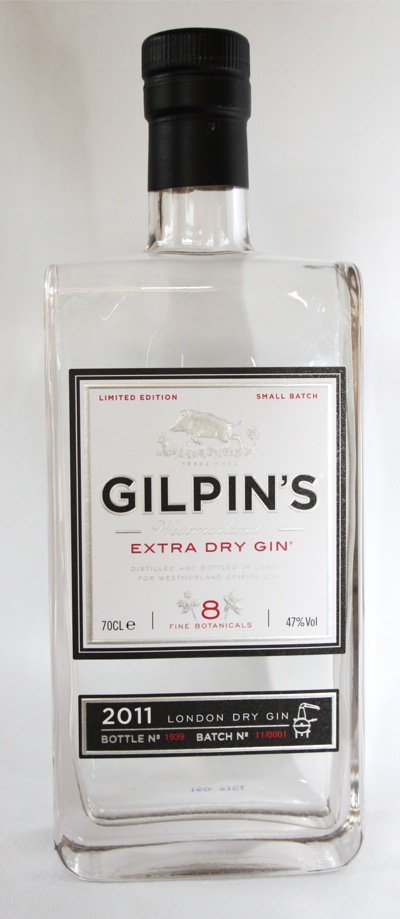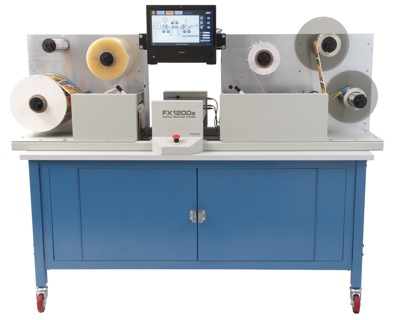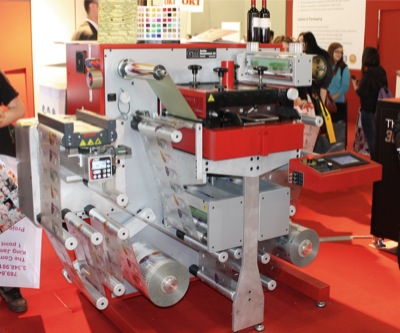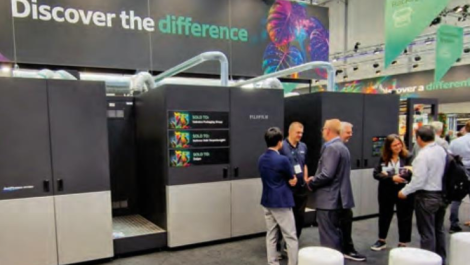Printing is only half the story when it comes to labels. Finishing completes the converting process and not only does it die-cut and rewind the labels, it also offers many options to add value to the product. By Neel Madsen.
Although it is the quality of the printing on the label that stands out for the consumer picking a product off the shelf, the finishing process is equally important whether it be precisely die-cutting the shape of the labels or adding high quality foiling effects or Braille.
For digital label printers, there are numerous finishing systems to consider; some presses feature inline converting while others require a separate offline machine. Standalone systems are most often modular in nature and can be tailored to requirements to include foiling units, embossing, flexo coating or varnishing, screen printing, hologram printing, along with the necessary die-cutting and rewinding.
Adding value
Danish manufacturer Grafisk Maskinfabrik (GM) offers digital finishing lines for labels and cartonboard that can be set up as inline extensions of the digital press or used for offline converting. Its DC330 and DC500 lines are modular platforms with speeds of up to 72 m/min and a maximum web width of 500 mm.
Options include lamination station, UV varnish, hot and cold foiling, screen printing, semi rotary or laser die-cutting, booklet inserter and screen printing. The DC330 also comes in a compact model with a footprint of 2 x 1 metres, and an even smaller nano version taking up just 1.3 x 1 metres of space.
At Grafitalia in Milan in May, the company had the DC330 on display running on the Xeikon stand; a system that was sold to Reynders Etiketten in Holland. It also presented the latest addition to its range, the FB330 flatbed hot foil system for foiling and embossing.
Advanced features such as foil saver, servo register, electronic temperature control and BST web guide come as standard with this machine. With a web width of between 100 to 330 mm, it offers converting speeds of up to 20 m/min depending on the substrate type and artwork. Uffe Nielsen, managing director, said, ‘GM has over the past years seen a rise in the demand for compact finishing equipment for digitally printed labels.
The new FB330 is the latest addition to the family of modules in this area. It provides an efficient way to add hot foil and embossing to wine and cosmetic labels. All the modules can be added easily to the main product.’
AB Graphic International has many systems installed and is expanding its offering to meet the demands from wider digital presses. Launching at Labelexpo, the new Digicon 3000 has been designed specifically to support the HP Indigo 20000 digital press specifications and will be integrated inline with the press, allowing one pass for optimised production of labels and flexible packaging.
DL&P spoke to Stuart Kellock, managing director at Label Apeel, about how the company adds value to its labels. ‘Our Digicon finishing line from AB Graphic has one flexo head, one flat bed screen head, one hot foil head, embossing capabilities, cold foil capability and laminating.
In today’s market, the ability to differentiate is absolutely paramount and that is the case if you are the brand on the supermarket shelf or ability to punch above their weight and larger brands the option to run trials and short run work, cost effectively.
What was at the outset a bit of a risk has paid off for us, as we continue to attract a wide range of companies from our target markets who want exciting, interesting and effective packaging. I think the best advocate is the number of new customers we are attracting.
In the first two weeks of January, a notoriously quiet time, we welcomed four new customers, and this is indicative of the numbers we have been attracting over the past 12 months. Obviously the machine is not the only part of the proposition that attracts new customers, but without it, we would not be able to offer the breadth of projects. their not inconsiderable bow.

We knew when we bought the machine that we would use the hot foil and embossing capability, but there was some concern about how competitive the flatbed screen would be, as it runs extremely slowly. We did not need to worry.
We have used the screen extensively since we got the machine. We have found that with the cost of flatbed screens compared to rotary screens and the ease of makeready, we remain competitive on run lengths up to 4000 metres and in some instances greater.’
Elite converting
Bar Graphic Machinery has developed the new Elite Digiflex full servo flexo print module and die-cut to re-register slitter rewinder. It converts and finishes pre-printed digital or flexo media. Highly flexible, it can also print, apply additional coating as well as semi rotary or full rotary die-cut, slit and rewind all in register in one or multiple passes.
Annemarie Rhodes, managing director, said, ‘Digital print run lengths can be tightly controlled and changes, small or large, can be made easily and quickly, right up to the last minute.
The flexibility of our new Digiflex is truly outstanding. It offers the ability and flexibility of converting and finishing valuable products, with the minimum of waste, in the fastest time to aid profitability.’
Key features include fast changeover for maximum productivity and flexibility as a result of the company’s Automatic Print Positioning (APP) system, which ensures highly accurate plate registration.
It also features Automatic Die Registration (ADR), which greatly reduces set up waste for a more cost efficient re-register print and die-cut production process.
A digital servo drive provides constant communication between all servo axis for high performance and functionality achieving re-register speeds of up to 160 m/min.
The system also boasts advanced operator and online machine diagnostics, optimum print management camera control, superior quality and consistency of print. Other options available are lamination and delamination stations, turn bar, cold foiling, inkjet and web inspection systems.

All in one
Some larger digital label printing systems come fully fitted with integrated finishing while smaller low cost digital label printers often have their own dedicated finishing units, performing the basic slitting and rewinding functions.
The modular concept of Stork Prints DSI UV inkjet press means it can either be supplied as a standalone printing unit or with an integrated semi-rotary finishing option.
EFI’s family of Jetrion 4900 presses, including the new 4900ML and 4900M-330, all offer modular integration of finishing capabilities. Focus Label Machinery’s d-Flex digital inkjet system includes flexo printing/coating, corona treatment, cold foil, laminating, varnishing and die cutting, either in roll to roll, or roll to sheet applications.
Daco Solutions has designed the DTD250R table top die cut Primera’s FX1200e digital finisher complements the CX1200e colour label printer by cutting, laminating, slitting and rewinding, controlled by a touch screen for easy operation. It features on-the-fly adjustment of job parameters saving on downtime.
Impression Technology Europe offers the Compress Eclipse LF3 digital label cutter, which Mark Andy demonstrated its new SRL 4.0 digital label printer at a recent open house event at its UK showroom where a new converting unit, the SRC (Short Run Converting) was also introduced.
Designed to process digitally printed labels, the SRC can handle web widths up to 330 mm, and has semi-rotary die-cutting and a self-wind laminating facility. It re-registers to an eye-mark, has razor slitting for multi streams, edge trimming and a waste matrix rewind.






